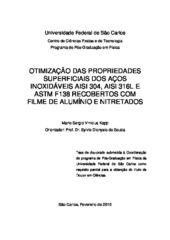Otimização das propriedades superficiais dos aços inoxidáveis AISI 304, AISI 316L e ASTM F138 recobertos com filme de alumínio e nitretados
Abstract
Many industrial applications of stainless steel require the modification of surface properties, such as corrosion resistance, and mechanical properties such as hardness. For this purpose several surface modify techniques have been used and researched. In this work, samples of three different stainless steels, AISI 316L, ASTM F138 and AISI 304 were coated with aluminum thin film with different thickness and plasma nitrided. The characterization of AISI 316L samples was performed by X-ray diffraction analysis, micro Vickers hardness measurements and by scanning electron microscopy (SEM). For samples of ASTM F138 and AISI 304, besides techniques further, were also performed Mössbauer spectroscopy analysis and corrosion tests (NaCl). The results for samples of AISI 316L indicated that is possible to form the AlN phase on the surface of samples with Al film and the nitriding parameters (temperature, time and pressure) has a fundamental role in the thickness and composition of the layer formed and the film adherence. Moreover, we observed that the thickness of the film influenced the formation of Fe2Al5 and AlN (Hex.) phases. The results of ASTM F138 samples indicated that the composition of the matrix seems to play an important role in the formation of the CrN film as well as the adhesion to the substrate seems to be important to increasing the corrosion resistance. As amostras de AISI 304 apresentaram resultados satisfatórios para o aumento da dureza superficial, cerca de 10 vezes a dureza da matriz, bem como para a resistência à corrosão, que para algumas regiões analisadas superou a resistência à corrosão da matriz. The AISI 304 samples showed satisfactory results for surface hardness, increasing about 10 times the hardness of the matrix, as well as corrosion resistance, that in some analized regions it was greater than the matrix. The procedures used in this work allowed us to select an efficient treatment method for increasing surface hardness of stainless steel, without losing its characteristics of corrosion resistance.
